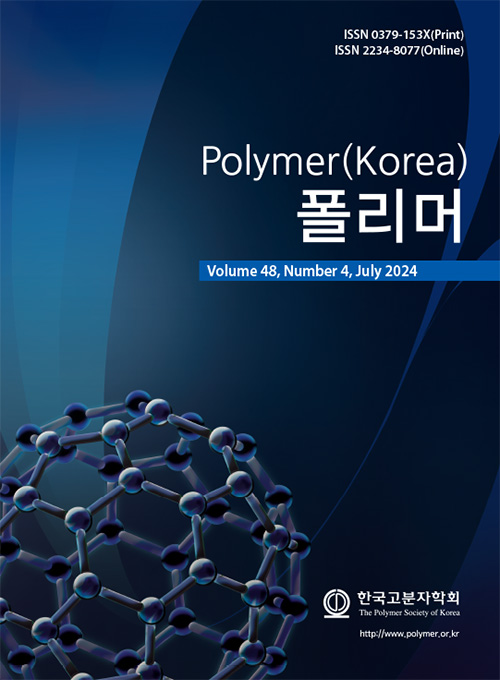- Effect of Hollow Microspheres as Reinforcing Fillers on Natural Rubber Composites
Meng Zhao, Linfeng Han, Lin Zhang, Yang Li**, Yuan Jing*,†
 , Ruifang Lv**, Huazhang Ma***, and Guangyi Lin†
, Ruifang Lv**, Huazhang Ma***, and Guangyi Lin† 
College of Electromechanical Engineering, Qingdao University of Science and Technology, Qingdao, 266033, P.R. China
*College of Civil Engineering, Qingdao University of Technology, Qingdao, 266033, P.R. China
**Beijing Huaqi Eco Technology Co., Ltd, Beijing, 100000, P.R. China
***Qingdao University of Science and Technology Guangrao Rubber Industry Research Institute, Dongying, 257029, P.R. China- 중공 미세구가 강화 충전제로서 천연 고무 복합재에 미치는 효과
Reproduction, stored in a retrieval system, or transmitted in any form of any part of this publication is permitted only by written permission from the Polymer Society of Korea.
This study aims to investigate the effect of a new hollow microsphere (RiM01) as a reinforcing filler for natural rubber (NR) instead of carbon black (CB) on rubber composites. The differences in vulcanization characteristics and mechanical properties of the natural rubber composites are being investigated by carbon black and hollow microsphere ratios. The results show that the addition of hollow microspheres decreases the tensile strength, abrasion resistance, and hardness of the rubber composites. However, when the hollow microspheres completely replace carbon black, the compression set is reduced from the initial 33% to 15%. In addition, the tensile and tear strengths of the rubber composites with 50 phr hollow microspheres are only reduced by 7.04% and 1.68% compared with those before aging; with 40 phr hollow microspheres, the 300% constant tensile stresses after aging are enhanced by 45% compared with those before aging. The aging resistance is improved.
Keywords: hollow microspheres, natural rubber, mechanical properties, compression set, aging resistance.
- Polymer(Korea) 폴리머
- Frequency : Bimonthly(odd)
ISSN 0379-153X(Print)
ISSN 2234-8077(Online)
Abbr. Polym. Korea - 2023 Impact Factor : 0.4
- Indexed in SCIE
 This Article
This Article
-
2024; 48(4): 367-375
Published online Jul 25, 2024
- 10.7317/pk.2024.48.4.367
- Received on Nov 27, 2023
- Revised on Mar 29, 2024
- Accepted on Apr 2, 2024
 Correspondence to
Correspondence to
- Yuan Jing*, and Guangyi Lin
-
College of Electromechanical Engineering, Qingdao University of Science and Technology, Qingdao, 266033, P.R. China
*College of Civil Engineering, Qingdao University of Technology, Qingdao, 266033, P.R. China - E-mail: 2777273463@qq.com, gylin666@163.com








 Copyright(c) The Polymer Society of Korea. All right reserved.
Copyright(c) The Polymer Society of Korea. All right reserved.